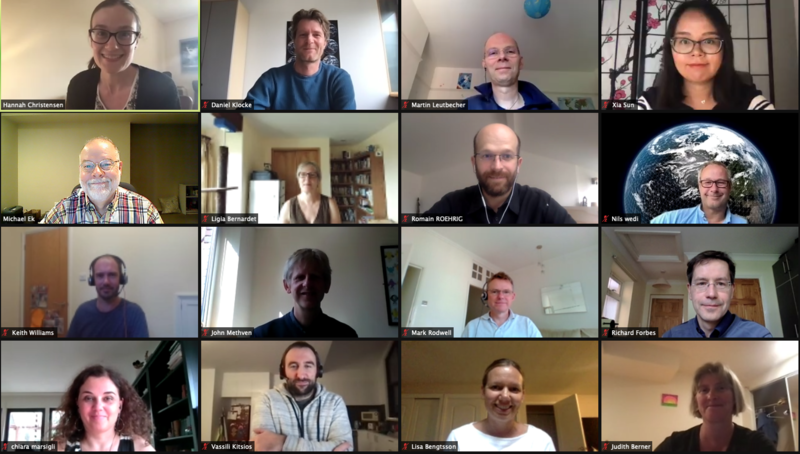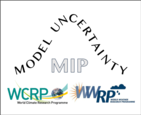MUMIP Meeting 2
23 June 2021, 15:00-16:30 UK time, Zoom
Attendees
Lisa Bengtsson (NOAA / CIRES)
Ligia Bernardet (NOAA / DTC)
Judith Berner (NCAR / WWRP PDEF)
Hannah Christensen (U. Oxford)
Mike Ek (NCAR / DTC)
Richard Forbes (ECMWF)
Vasilli Kitsios (CSIRO)
Daniel Klocke (MPI Hamburg)
Martin Leutbecher (ECMWF)
Chiara Marsigli (DWD)
John Methven (U. Reading / WWRP PDEF)
Mark Rodwell (ECMWF / WWRP PDEF)
Romain Roehrig (CNRM)
Xia Sun (NOAA / DTC)
Nils Wedi (ECMWF / WCRP WGNE)
Keith Williams (UK Met Office)
Agenda
1. Updates from participating groups (all)
- Mike Ek, Ligia Bernardet
Funding from NOAA-NCAR Developmental Testbed Center, three years from May 2021. Goal for year 1 is getting everything working. Years 2 and 3 are analysis.
- Romain Roehrig – new participant
Primary interest is systematic error in CNRM SCM, but others in CNRM interested in stochastic parametrisations, especially in S2S community
- Keith Williams
Progress exploring technical issues around DEPHY format and UKMO SCM
- Richard Forbes
Progress in creating tool to convert DEPHY format to IFS SCM format with Hannah
- Vassili Kitsios – new participant
Long running interest in using high-resolution simulations to develop data driven parametrisation schemes. Has performed preliminary analysis on Christensen et al (2018) coarse graining/SCM dataset, and has found consistent results with earlier work
- Hannah Christensen
Has generated prototype coarse-grained input fields. One day – 8 timesteps. 0.2o resolution, Indian Ocean region.
CDO conservative remapping to do coarse graining from ICON 2.5 km to new grid. Native ICON model levels, no temporal interpolation (3 hourly).
Pseudo-DEPHY format. Instructions for using files with DEPHY format SCM will be included in header of files.
DK – would be able to generate an extra day of data archived hourly using ICON 2.5km for sensitivity testing
VK – better to interpolate than to mask out land points (for spectral analysis)
RR – update of DEPHY format. Many attributes moved to normal variables. Protocol will be published in the next 6-9 months.
JM – avoid duplication of humidity variables. Remove all ‘r’s
LigiaB – may be inconsistencies in partitioning of water species between different models. Not sure whether there is added value in including Qi and Ql. The users may need to think about this.
DK – suggests HC contact Florian for permanent space at DKRZ. May need to write a proposal. DK could head this up if need be. Acknowledge ESIWACE.
RF – points out that qt only contains qv + qi + qt. Suggest removing that variable as well.
KW – most useful to get test dataset out which users can test. We can iron out these details later
DK – discussion in chat. IFS 4km Dyamond summer simulation has hourly output. Could create test dataset for that simulation
JB – could we put the data in the cloud – e.g. AWS. But might need to convert netcdf files to .zarr files.
LigiaB – But data egress from cloud can be costly. If it was AWS, it would be good for NOAA, but otherwise it would be best to put it on a globus point.
2. Funding opportunities (Hannah Christensen)
- To what extent is funding to hire PDRAs a limiting factor on participation for each group?
ME – There will be more funding opportunities coming up from NOAA over coming months
VK – funding would enable me to spend more time on project
KW – funding can’t come to UKMO. But if someone at a university was funded to do the runs, that would be massively helpful.
NW – similar situation at ECMWF to UKMO
- What funding opportunities are available to address this need, either individually or as groups of participants?
HC reported on Leverhulme ‘Research Project Grant’. Can have up to three co-applicants from any institute. Can employ local researchers. Approx 10-postdoc-years funded. Caveats: no overheads, and co-applicant cannot claim salary. Outline applications are fairly short.
DK – One option is for postdocs to all sit in Oxford, and run the SCMs with support from Met Agencies
NW – easier to have PDRA sit at university, whereas very difficult to employ someone at ECMWF
KW – Met Office same as ECMWF
CM – DWD hiring bureaucracy is very complex. But if we take part, having time to run SCM wouldn’t be biggest issue.
RR – Meteo France also has heavy bureaucracy. But why not – this project needs time to do it properly. Will enquire.
JM – Leverhulme very keen on interdisciplinary. Primary criterion is to ‘transcend disciplinary boundaries’ – e.g. stress crossing maths and weather/climate
JB – Even if we only have one PDRA they could coordinate the diagnostics. Note the ‘no overheads’ caveat as this might be difficult for many institutes. Can the money go to existing people or does it need to be new hires?
NW – Is there someone already in the team who will do the common diagnostics?
Next steps: email Hannah if interested.
3. Suggestion to broaden the scope of the project (Judith Berner)
JB discussed potential to use the coarse-graining method to validate high-resolution models. Compare many convection permitting simulations on a coarser scale to make statements about the fidelity of the high-resolution models. Increase potential funding resources and interest from high-resolution community.
ME – there is experience within the group on these issues. Would be nice to understand connections between the scales
CM – this was discussed at DWD in pre-meeting. Biases in models are very different across different resolutions. Assessing how model behaviour changes with scale very important.
JB – very least we can do is coarse grain two high-res models and compare them at the coarse scale.
NW – SCM useful tool for this, as we know fidelity of dynamical tendencies important for behaviour of SCM.
Generally strong support from the groups as to adopting this proposal
HC and JB to draft sentences to add to website.
4. Website - comments and suggestions (Hannah Christensen)
Hannah reported on website. A way to advertise MUMIP to interested parties. Also a resource for us, where we can put documentation and practical information.
JM – Add WWRP and WCRP to logo soup
DK – add physics driven stochastic schemes (Mirjana Sakradzija’s work)
5. Next steps and timeline
HC – Is there interest in a demonstration of existing SCM automation software?
Yes – HC to schedule meeting for 4-6 weeks’ time.




